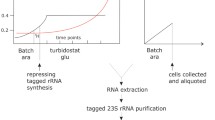Abstract
IT has been thought that the rel gene in Escherichia coli is responsible for the stringent control of stable RNA synthesis dependent on a supply of amino acids, since the gene was identified as the site of mutation to the relaxed phenotype1. But in our previous reports2,3, we suggested that mutational defects in rel− cells are probably in the translational mechinery, the integrity of which may be required for stringent control. This supposition is based on the following observations: (1) When rel− cells are shifted down in carbon or nitrogen source, the stringent control of RNA synthesis is observed in spite of their rel− genotype2,4. Only when deprived of amino acids do rel− cells fail to restrict RNA synthesis, in contrast to cells having the rel+ allele. (2) Ribosomal inhibitors like chloramphenicol abolish the stringent control in both rel+ and rel− cells2,5,6. Furthermore, a cold-sensitive mutant defective in protein synthesis at low temperature earring a mutation in spcA locus, also shows the relaxed phenotype under non-permissive conditions3. It has been reported that several other mutants of rel+ strains having temperature-sensitive phenylalanyl-tRNA synthetase7, peptidyl-tRNA hydrolase8, or elongation factor G (ref. 9) all failed to control the synthesis of RNA at the higher temperature. This suggests that normal synthesis of protein is required for stringent control. (3) During shift-down of a carbon or nitrogen source there is no difference between the growth of rel+ and rel− cells. Only after shift-down of amino acids do rel− cells require a much longer lag period before they resume growth2,10. This is due to the inability of rel− cells to carry out the normal synthesis of protein when the supply of amino-acids is limited.
Similar content being viewed by others
References
Stent, G. S., and Brenner, S., Proc. natn. Acad. Sci. U.S.A., 47, 2005 (1961).
Sokawa, Y., Sokawa, J., and Kaziro, Y., Nature new Biol., 234, 7 (1971).
Sokawa, J., Sokawa, Y., and Kaziro, Y., Nature new Biol. 240, 242 (1972).
Neidhardt, F. C., Biochim. biophys. Acta, 68, 365 (1963).
Pardee, A. B., and Prestidge, L. S., J. Bact., 71, 677 (1958).
Aronson, A. I., and Spiegelman, S., Biochim. biophys. Acta, 53, 70 (1961).
Atherly, A. G., and Suchanek, M. C., J. Bact., 108, 627 (1971).
Atherly, A. G., and Menninger, J. R., Nature new Biol., 240, 245 (1972).
Rabbani, E., and Srinivasan, P. R., J. Bact., 113, 1177 (1973).
Alföldi, L., Stent, G. S., Hoogs, M., and Hill, B., Z. Vererbungslehre, 94, 285 (1963).
Fiil, N., J. molec. Biol., 45, 195 (1969).
Hall, B., and Gallant, J., J. molec. Biol., 61, 271 (1971).
Gallant, J., Erlich, H., Hall, B., and Laffler, T., Cold Spring Harb. Symp. quant. Biol., 35, 397 (1970).
Fiil, N., and Friesen, J. D., J. Bact., 95, 729 (1968).
Edlin, G., and Broda, P., Bact. Rev., 32, 206 (1968).
Schlessinger, D., The Mechanism of Protein Synthesis and its Regulation (edit. by Bosch, L.), 441 (North-Holland, Amsterdam and London, 1972).
Godson, G. N., Methods in Enzymology, 12 A, 503 (1967).
Ron, E. Z., J. Bact., 108, 263 (1971).
Silengo, L., J. Bact., 115, 447 (1973).
Cozzone, A., and Donini, P., J. molec. Biol., 76, 149 (1973).
Engbaek, F., Kjeldgaard, N. O., and Maaløe, O., J. molec. Biol., 75, 109 (1973).
Hall, B., and Gallant, J., Nature new Biol., 237, 131 (1972).
Pedersen, F. S., Lung, E., and Kjeldgaard, N. O., Nature new Biol., 243, 13 (1973).
Haseltine, W. A., and Block, R., Proc. natn. Acad. Sci. U.S.A., 70, 1564 (1973).
Haseltine, W. A., Block, R., Gilbert, W., and Weber, K., Nature, 238, 381 (1972).
Author information
Authors and Affiliations
Rights and permissions
About this article
Cite this article
SOKAWA, Y., SOKAWA, J. & KAZIRO, Y. Role of rel gene in translation during amino acid starvation in Escherichia coli. Nature 249, 59–62 (1974). https://doi.org/10.1038/249059a0
Received:
Issue Date:
DOI: https://doi.org/10.1038/249059a0
- Springer Nature Limited
This article is cited by
-
A new gene in E. coli RNA synthesis
Molecular and General Genetics MGG (1983)





